What is cupra and how is cupro made? Cupro, or sometimes called cupra, is the short term for cuprammonium rayon and is a regenerated cellulose fabric which is made from cotton linter, a cotton waste product. It is a vegan alternative for silk and if you are wondering what is Bemberg fabric, it is an American name for cupro material.
What is Cupra?
Cupro is made from cotton linter which is a waste product of cotton production. It is a regenerated cellulose fabric which is made from cotton waste, called linters. 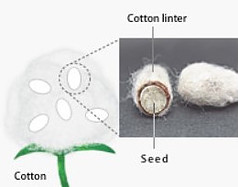 Cotton linters are the short, fine fibers that are left behind on the cotton seed after the ginning process is complete. Ginning is the process in cotton production that separates the long, staple cotton fibers from the cotton seeds.
Cotton linters are the short, fine fibers that are left behind on the cotton seed after the ginning process is complete. Ginning is the process in cotton production that separates the long, staple cotton fibers from the cotton seeds.
Linters is like a fuzzy down and it is normally discarded. So it is a byproduct of cotton processing, but it is used to make a sustainable fiber. Read more about cotton production in this post on what is organic cotton clothing.
So cupro is a plant based material that is chemically processed to produce a smooth fabric. It therefore falls in the same category as viscose, rayon, lyocell, modal and Tencel (which is an American brand name for lyocell viscose)
Cupro is also known as cuprammonium rayon, ammonia silk, cupra and Bemberg fabric, which is a trade name that was registered in America. Cupro and cupra are the slang names that are used in the Chinese manufacturing facilities. Ammonia silk is not really a good ambassadorial name for a fabric, as you don’t really want ammonia to be in direct contact with your skin.
China is the biggest producer of cuprammonium rayon and Cupro is also mixed with other natural and synthetic fibers to make the vegan alternative for silk. But how is cupro made?
How is Cupro Made? 
The production of cupro is not really a simple process and is also not wholly sustainable. The strands that make up Cupro are tiny and too small to be spun and woven, which is why they are normally discarded.
These are the steps of what is bemberg fabric and how is cupro made:
- A cuprammonium solution is used to purify cellulose.
- Cuprammonium rayon is made by exposing the cellulose from the cotton to a mixture of copper and ammonium.
- These two chemicals combine with the cellulose to form a new substance.
- This mixture is put into caustic soda.
- It is then extruded through a spinneret to get filaments.
- The filaments are immersed in a series of hardening baths. The cellulose is regenerated in the hardening baths which remove the copper and ammonia and neutralize the caustic soda.
- These baths can be used several times, but eventually it has to be disposed of.
But what is cupro used for and how sustainable is it really at the end of the day?
Properties of Cupro Fabric
The properties of cupro, this vegan alternative for silk, also make it ideal for designer resort wear women garments.
- Cupro is light and breathable, making it a perfect option for the beach.
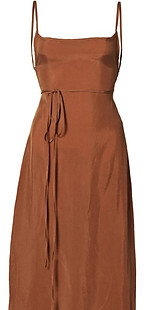
- It has an elegant drape and luxurious look.
- Cupro is a breathable fiber that has micro pores that absorbs moisture quickly and release it to the outside.
- It has moderate moisture wicking abilities which regulates the body temperature by effectively reducing clinging and transporting moisture away from the skin.
- Cupro has moderate heat retention abilities.
- It has a high tendency to pilling and bubbling.
- The fabric is reasonably stretchy and resistant to stretching out of shape at higher temperatures.
- Cupro is hypoallergenic and anti-static
- Garments made from cupro travels easily and is wrinkle resistant.
- Cupro fabric care is simple as it can be machine washed and dried.
Cupro fabric is very fine with a very high thread count, making it suitable for lingerie, fine garments, shawls, evening wear, blouses, light and form fitting clothing. It is regarded as a vegan alternative to silk because of the fineness.
Advantages of Cupro
The material and processes of how is cupro made, have several advantages: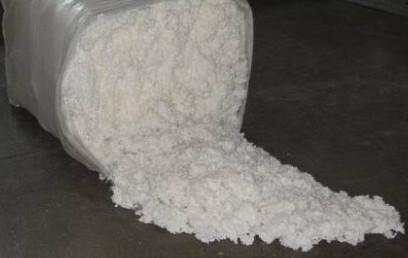
- Linter, which is a waste product of cotton processing, is used to make cupro.
- It is lightweight and breathable.
- It easily mixes with other fibers and is often blended with cotton or linen.
- Biodegradable, which is a big bonus in the current climate.
- It is sheer and has good elasticity.
- Hypo allergenic and anti-static.
- It dyes fantastically and produces vibrant prints.
- Cupro fabric care is easy as it is machine washable on a cold cycle.
- Cupro is completely vegan friendly, making it a perfect vegan alternative for silk.
- Much less waste water is created than with producing cotton.
Disadvantages of How is Cupro Made
- Very harsh chemicals are used in the process.
- It easily ignites at temperatures above 180°C.
- It chars when it burns and leaves a coppery residue.
- Only cold tumble drying and it can only be washed on cold.
- Cupro gets very heavy when it is wet.
- China has accumulated a large amount of waste at a low cost, and instead of looking for solutions to the environmental crisis, they are simply making money with waste products.
The Environmental Impact of How is Cupro Made
But is Cupro friend or foe? What is Cupra used for and is it environmentally friendly? The purpose of making Cupro is to reduce the amount of waste caused by the cotton industry, so in this sense, it is a positive development.
- A closed loop manufacturing process is used, meaning that the wastage can simply be reused. This means the amount of resources that are used to create each garment, is reduced when more fabric is produced.
- Cupro is a fabric that is very easy to dye and absorbs colors beautifully. The dyeing process for many fabrics is extremely wasteful and many harmful chemicals are used. So any improvement in the efficiency of the dyeing process, has a positive impact. Related posts: Fabric Dye: How eco friendly is it? and What is Fabric Dye?
- It is biodegradable and easy to recycle.
But there are also negative aspects to what is cupra: 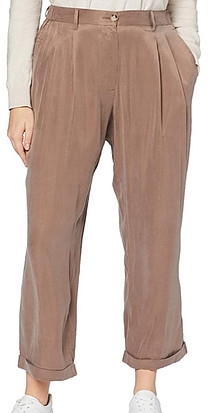
- Despite using a waste product or recycled cotton, cuprammonium rayon has a large negative impact on the environment.
- Copper, ammonia and caustic soda are all cheap materials, making it very inexpensive to produce cuprammonium rayon. These harmful substances are normally not disposed of safely. Related post: Beware of Toxic Chemicals in Clothes.
- There are currently no certifications for cupro as it is a dirty process.
At the end of the day, the composition of cupro is cellulose fibers from cotton which has been exposed to copper, ammonia and caustic soda, to give you a man made semi synthetic textile.
So cupro really is a bit of a controversial fabric. It falls in the no-man’s land between natural fibers and synthetic fibers, yet it is biodegradable and is made from a waste product. The harsh chemicals that are used, is what puts me off wanting to buy cupro clothing that has been made with Chinese cuprammonium.
But if cupro has been made with cotton and linen blends, then it is a different story and perfect for designer resort wear women clothing.
Cupro Fabric Care
How do you wash and care for Cupro?
- Cupro is normally machine washable, but it is best to check the care instructions on your clothing.
- Using a gentle cycle like wool or silk, will be gentle on the fibers and dye of your Cupro garments.
- A cold cycle is advisable.
- Keep away from high heat as it chars easily.
 Several brands are incorporating the vegan alternative for silk in their designer resort wear women collections.
Several brands are incorporating the vegan alternative for silk in their designer resort wear women collections.
Anemos Swimwear
Anemos Swim is an American label that is based in Southern California and garments are made in Los Angeles, USA. It was founded in 2018 by two designers, Lauren Arapage and Joshua Shaub, that wanted to create swimwear that is cool, but also classic. The impact on the planet is at the core of their production.
Inspiration for the line of swimwear and designer resort wear women range, came from one of Kate Moss’s minimilistic dresses from the 90’s. They originally designed under the name Anemone, but it has been re branded as Anemos, which comes from the Greek word meaning wind.
Their collection is meant to be mix and match and also to be combined with shorts, skirts and jeans. All fabrics are sustainable and they work with local, family-run factories in Los Angeles. This allows them to be closely involved in each step of their supply chain. In order to reduce the use of water, energy, chemicals and waste, every single stage of the production cycle is monitored.
Sustainable fabrics and practices that are used, include these:
- Italian Sensitive Fabrics and Brazilian Amni Soul Eco fabric is used for swimwear. The materials are eco friendly and offer ultra violet protection of UV50+.
- The designer resort wear women collection is available in Cupro and 4 types of cupro
 are used in the Anemos designer resort wear women:
are used in the Anemos designer resort wear women:
- Japanese Cupro is used for ready to wear. It is a sustainable vegan alternative for silk and this fabric is both vegan and Global Recycled Standard (GRS) certified. Cupro fiber is made in Japan to strict Japanese standards with absolutely no factory pollution. Only clean water systems are used, which means that nothing at all is released into the environment during production. To give it a super soft hand feel and a more matte finish, the Japanese cupro is sand washed. Sand washed Japanese cupro is 100% cupro.
- Turkish linen cupro is a blend of 58% linen and 42% cupro. The linen cupro blend is more opaque than ramie and has a super soft and luxurious hand feel. It has a sophisticated look and is perfect for designer resort wear women, the beach and the city.
- Also uses Turkish stretch cupro, consisting of 56% cupro, 40% viscose and 4% elastane. The stretch cupro has a super soft hand with elastane to hug the body. Cupro breathes well, thus making it the ideal fabric for bodycon styles that can be worn in warm weather.
- And Turkish leopard print cupro, which is imported from Turkey. .
- Ramie is also used for resort wear. Ramie resort wear fabric is made in Spain. The fabric is eco friendly and the highly sustainable fiber is an alternative to synthetic fabrics.
- Eco friendly packaging and stationary from an officially certified LA Green Business is used. Packaging is 100% compostable, including a reusable mesh wash bag for washing swimwear and resort wear.
- Ships with Anemos wash bag.
Nightswim uses Cupro Fabric
Nightswim is based in Los Angeles and focus on sourcing local materials to produce sustainable beachwear and towels. They use a factory in downtown Los Angeles that prides themselves on using high quality craftsmanship, with a strong ethical and sustainable ethos. They spent two years doing research, developing and testing on how to apply the principles of eco and ethical design. 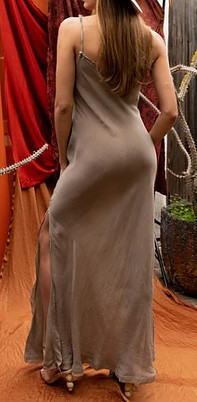
Sustainable fabrics and practices used by Nightswim include these:
- Blend of recycled PET and organic cotton to make terry fabric. Recycled plastic bottles from post consumer waste is used as raw material. By blending it with natural organic cotton, it eliminates the synthetic feel. Organic cotton is responsibly grown and produced, without the use of harmful chemicals like pesticides and fungicides.
- Supple soft challis is a woven fabric made with viscose (link viscose post), a natural cellulose fiber that comes from a renewable resource, namely beech trees. The cellulose fibers are bleached using an environmentally friendly bleaching method.
- Cupro is used in the new PAUSA collection. Is a cellulose fiber, made from cotton linter, which is often discarded because of the small length of the fibers. It is basically a textile manufacturing waste, but the cotton waste is woven into a soft material. PAUSA collection is since 2020 made in the southwest desert of Texas.
- Use azo free dyes that are free of toxic chemicals and heavy metals, so there is less grey water and chemical runoff into the environment.
- Packaging is a bio cassava bag which is biodegradable and compostable, but can be used as a high performance bag for carrying weights.
Their collection cares as much about the environment as they care about the people who wear it.
Ayla Swim
Ayla swim was started by two friends, Kirsty and Heidi, and the range of swimwear and designer resort wear women dresses are made in two small boutique factories in Bali. 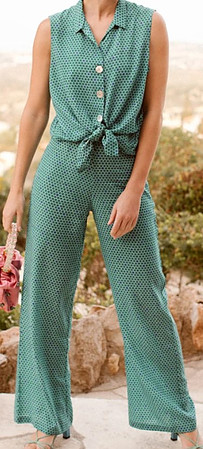 They produce separates that work together in many ways.
They produce separates that work together in many ways.
They are using cupro for sarongs, shirts and trousers in their Coral Collection. All pieces are made from Cupro, a sustainable fabric that is made from linter, a byproduct of the cotton production. This byproduct would normally be discarded.
The waste is minimized by using a closed loop production system to make the cupro fabric. Cupro looks, feels and behaves like silk.
The green brand Armour Vert is also using cupro in a few garments.
Sustainable and ethical swimwear is discussed in these related posts:
- Best sustainable swimsuits for women.
- 9 Swimwear brands that are swimming towards sustainability.
- Best swimwear for men from ocean plastic waste.
- Best ethical swimwear for women.
Final Thoughts on What is Cupra
Re purposing waste product from cotton production into a new product like cupro, is a great step towards reducing the textile manufacturing waste. Making Cupro is not an easy process, but the fine textile has a luxurious feel and is often used as a vegan alternative to silk.
Despite the chemicals and solvents that are used, many people feel that the environmental footprint of cupro is lower than synthetic materials. It is currently a solution to the textile waste problem when producing cotton. Cupro is a technological step in the right direction towards more circularity in textile manufacturing.
You can get Cupro clothing on Amazon by using this link if you are in the UK. And use this link if you are in the USA and are interested in exploring cupro clothing.
If you have any questions or experience about how is cupro made, the vegan alternative for silk, or what is cupra, then please leave your comments below and I will get back to you.

hey thankyou for sharing this…. can I also know about the market scenario of cupro fiber?
Hi there, I am not sure what you mean by the market scenario of cupro fiber. So please give me more details to respond.
I love cupro ever since I stumbled upon a t-shirt in cupro material 2 years ago from “& other stories” (Sweden). Now I have exactly 9 cupro t-shirt that I literally live in 24/7 when I’m at home! I use some as day wear and some as night wear. I also have a couple of leggings, turtle necks blouses and one dress in cupro. The reason why cupro has became my absolute favourite material is because of how breathable it is, and how soft it is. I can’t stand material that feels uncomfy, scratchy, stiff or hot in any way, not even cotton or viscose in many instances, so cupro is perfect as its so smooth and airy even though the material is a bit heavier then cotton etc.
All my gaments in cupro are all 95% cupro and 5% elastan (or nylon) and they have all kept their shape and color during these years. I wash them in the machine washer in the hand washing program or sometimes “mild 30C” program.
I see that one of the negatives mentioned in the text is “pilling and bubbling”, which made me confused because none of my cupro garments has ever pilled or bubbled. The material is too smooth for that! I can’t see how it would occure any pilling at all, so that information is wrong in my experiences with the material.
I have noticed that the materials smoothness and weight varies depending on the brand. The cupro garments I have from (to me) pricier brands has smoother and lighter textures but overall I have not noticed much differences in quality atleast with my t-shirt. My blouses on the other hand seems more sensitive and they also are much lighter and thinner.
Some negatives with cupro is that it becomes very heavy when wet and it soaks up water very easily if you are to spill water over yourself, but it air dries very quickly. It does not air dry so quickly when the garment comes out of the washer though. I air dry my garments on drying racks and preferably in vertical position as its sensitive when its wet just as viscose is. One other negativve may be that its, a draping material, if one likes super light weight materials like very thin viscose or thin silk, cupro is not it. I happen to quite like the weight of cupro though.
Cupro to me still is a mysterious material and its still hard to come by in Europe atleast. Also its too bad its not that sustainable with all those chemicals they use and that it lacks certification. However I’m in love with cupro <3 and I'm always am on the lookout for garments in cupro.
This is great to hear that you enjoy wearing cupro and thanks for sharing your personal experience. The pilling and bubbling that can occur, is invariably with the cheaper brands. But as you say, you have opted for a pricier brand, and therefore the quality is better. All the best.
This post is very informative for me! I haven’t heard of cupro or cupra clothing until I came into this article. I already heard of lyocell as I am also trying to be more environment-friendly with my purchases including clothing. The next time I buy clothing for my family, I will check if there are already clothes made of cupro here in Spain. Are they affordable? Clothing made of lyocell is a bit expensive than cotton ones in my observation.
Clothing made from cupro is affordable and this is the link where you can buy cupro clothing if you are in Spain. Lyocell is a trade name for viscose fabric and in my experience it is normally cheaper or similarly priced as cotton. Organic cotton is often more expensive because of the production processes, but you know that you then a fabric that has been made without harmful chemicals and pesticides. I hope this helps.
I live in Europe too (Sweden). You can sometimes find cupro garment in some brands collections such as Mango, & other stories. Zalando has a t-shirt from Samsoe in cupro (a bit pricy though). But be aware that sometimes a garment can have the headlight cupro but when you read the “material decription” information its lyocell, tencell . I have seen this missnaming in for example zalando.
Lyocell and tencell usually refers to the way in which the fabric was made. If the lyocell process is used, it means it is an eco friendly process and made in a closed loop system. It is a process that is used for several man-made fabrics, including viscose and cupro. I hope this helps.
Wow, this is a very neat idea that helps reduce waste and create something valuable with it. Win-win scenario!! It’s too bad that the current cupro production methods are not totally without their flaws and drawbacks. It sounds like overall it’s a step in the right direction as a smart method of reducing waste but still has some room for improvement on the environmental aspects of production.
Making Cupro from cotton waste is indeed a step in the right direction, but the toxic chemicals that are used does worry me. With technological advancements, different procedures are being introduced to make the process more eco friendly.
Very detailed on how this is made and the impact on our world from producing cupro. Such a fascinating article on cupro, I have never heard of it but probably seen it worn on people many thousands of times. Hopefully, your article gets more people familiar with this clothing product because it is more environmentally better than other man-made materials.
To produce fabric from waste will help with converting textile byproducts and as technology advances, more eco friendly processes are incorporated.
Thank you for this enlightening article. I had no idea there was a vegan alternative to silk and the fact that they are using waste from cotton is certainly good for the environment.
Now if only they could discover a way to produce it without the harsh chemicals it would be a more sustainable option.
I have very sensitive skin and the harsh chemicals are a very real concern to me.
Have you heard of anyone having skin issues because of this process?
Although I have not heard about skin issues with cupro, it is known that chemicals can cause rashes, eczema and other allergies reactions. I would suggest that you use organic fabrics like organic cotton, or hemp, linen and bamboo that are grown without any chemicals. I hope this helps.
Thanks for this article Cupro: A Vegan Alternative for Silk, which was really interesting to read. Perfectly described what it is, how it is grown, and the properties of the material.
Although the idea is great as it is a waste of cotton production, it would be more environmentally friendly to invent a better way to process Cupra because the current process is so demanding and conditioned by the use of chemicals. But given that technological processes are constantly evolving, hopefully, some better procedures for recycling waste in cotton production will be introduced soon.
I wish you all the best
Nina
Hi Nina, with advances in technology more eco friendly processes are introduced. Less chemicals are used in the cupro and natural fiber blends, so hopefully that will become more the norm.
I have to tell you honestly that my considerations on a vegan lifestyle never went past food. I can see now how silk would be a problem. While I would have put forth satin as a viable vegan alternative, I can see how cupro would do better. The fact that it’s made from (previously) discarded cotton byproducts alleviates waste. It also is biodegradable, comfortable, and breathable. Sounds like a win-win all the way around!!
Satin is actually a finish on a weave, rather than the fiber itself. Most satin is made from chemically produced synthetic fibers, which are vegan, but bad for the environment and your skin. So the fact that cupro is made from cotton waste and is biodegradable, does make it better.
Intersting..An alternative for silk. I am new to learning about fabrics and things being Vegan friendly. If you don’t mind me asking, could you explain to me what does that really mean? If the fabric isn’t vegan friendly then what would it be considered? I’m just curious on how all of this works.
Either way, It sounds like Cupro is a positive development. I’ve never tried to dye fabric before but, there were times when I wish I could dye the fabric. So, I like the fact that you can easily dye the fabric. I must admit that I don’t like the fact that the Cupro can easily ignite but, hey I guess all fabric could actually be considered easily ignited.
Hi there, if somebody follows a vegan diet, they do not eat any produce that are from animal origin, so apart from no meat, fish or poultry, also no dairy products, honey or any animal products. If somebody is looking for vegan friendly fabrics, there must be no animal products in it either, so no silk or wool.
Synthetic fabrics also ignite very easily, whereas natural fibers are more flame retardant.. I hope this helps.
I’m always excited about new ways to make a wasted material into something useful. I have a concern running parallel to it, though: How do we achieve a commensurate reduction in the manufactured goods made from oil and other harmful materials? Ultimately, more manufactured goods are just more manufactured goods. If regenerated materials aren’t replacing wasteful materials, then we’re only a little detour on the linter’s way to the landfill. It’s necessary (and joyful) to invent usable materials from waste, but it’s not sufficient. We can’t consume our way our of a waste problem. We also have to actively oppose the goods that are killing us.
I couldn’t agree with you more. We have to stop producing stuff that is not just bad for us, but bad for the environment, and then end up in landfill.
Until I read your article, I had no idea about cupro. I liked how you explained how to make it (especially since cotton parts that would otherwise be thrown away are used). The photos posted look superb. But I did not understand if cupro can only be washed cold, how can you dry them in the dryer? Or did I not understand?
When it comes to cupro fabric care, it is best to wash it in cold water. If you do want to put it in the dryer, you have to use a cold cycle. I hope this has clarified it for you.
Um, I now I’ve done this twice already. So, I am just going to say refer back to my first review.
That said, if I might add, your competitive advantage is your desire to make the world a better place. Your eco-friendly mentality will take you a long way especially if you find the right audience who are interested in similar hobbies/lifestyles/developments.
Moreover, you do an excellent job not only explaining jargon with meaningful context but also helping the unconverted, uninitiated appreciate the inherent value of your vegan alternative for silk: cupro.
An eco friendly mentally is much better for the planet and your health, than a wasteful, disposable mindset.
This is a piece of very useful knowledge. As a vegetarian that started to turn into a vegan lifestyle, I’ll try to replace some of my most used things, including clothing. It seems there is a lot of advantages to wearing Cupro clothing, but do you think it’s better compared to Viscose clothing? Thanks for your opinion.
Viscose and cupro both fall into the category of man made fibers. Personally I am wary of the amount of harmful chemicals that are used in how is cupro made. The natural vegan fibers would be cotton, hemp, linen, bamboo, rubber and even coir and ramie, so you might want to look at those as well.
I loved this! I never thought of clothing as vegan. That was a very neat perspective that expanded my mind. You do an amazing job outlining the pros and cons, advantages and disadvantages of cipro as a vegan alternative for silk.
I especially appreciated how you ended this article on how cupro is the eco-friendly, less wasteful option. Luxurious is a word that I would use to described the breadth of your knowledge. Even some of the jargon makes perfect sense within the content of your vegan alternative proposal.
Oh, silky, silky!!!
Thank you for your kind comments and cupro is indeed a very good vegan alternative for silk.